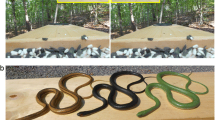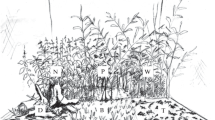Summary
In an aviary experiment with captive Goldfinches (Carduelis carduelis L.) vigilance and foraging behaviour were recorded before and after the appearance of a predator. When foraging, individual Goldfinches had a low head jerk rate during the first minute, but each scan was of relatively expanded duration; the scanning rate increased with a shorter duration of each scan up to the time the predator, a Merlin (Falco columbarius), appeared. Thereafter the birds showed a low head jerk rate, which returned to the former level after ten minutes. The time spent feeding was low if head jerk rate was low and high if head jerk rate was high. There were significantly more scans of long duration after the predator was visible compared with undisturbed feeding. The intake loss of individuals due to increased vigilance after the appearance of the predator during the following minutes is calculated to be 53%. A linear, negative regression function is formulated relating the number of scans per time unit and total time spent scanning:
With increased number of scans the total time spent vigilant is decreased. From this is concluded that if birds ingest relatively large sized seeds and therefore only a few per time unit they gain a higher security against predators compared to feeding on small sized seeds and ingesting relatively more, because time not spent vigilant is increased with increased pecking rate.
Similar content being viewed by others
References
Caraco T (1979) Time budgeting and group size: a test of theory. Ecology 60:618–627
Caraco T (1981) Energy budgets, risk and foraging preferences in Dark-eyed Juncos (Junco hyemalis). Behav Ecol Sociobiol 8:213–217
Caraco T (1983) White-crowned Sparrows (Zonotrichia leucophris) foraging preferences in a risky environment. Behav Ecol Sociobiol 12:63–69
Caraco T, Martindale S, Pulliam HR (1980a) Avian flocking in the presence of a predator. Nature 285:400–401
Caraco T, Martindale, Whittam (1980b) An empirical demonstration of risk-sensitive foraging preferences. Anim Behav 28:820–830
Curio E, Klump G, Regelmann K (1983) An anti-predator response in the Great Tit (Parus major): Is it tuned to predator risk? Oecologia (Berlin) 60:83–88
Glück E (1985) Seed preference and energy intake of Goldfinches Carduelis carduelis in the breeding season. Ibis 127:421–429
Glück E (1986) Benefits, costs and optimal flock size of social foraging in Goldfinches. Ethology (in press)
Grubb TC Jr, Greenwald L (1982) Sparrows and a brush pile: foraging response to different combinations of predator risk and energy cost. Anim Behav 30:637–640
Hart A, Lendrem DW (1984) Vigilance and scanning patterns in birds. Anim Behav 32:1216–1224
Hegner RE (1985) Dominance and anti-predator behaviour in Blue Tits (Parus caeruleus). Anim Behav 33:762–768
Klump GM, Curio E (1983) Reactions of Blue Tits parus caeruleus to Hawk models of different sizes. Bird Behaviour 4:78–81
Krebs JR (1980) Optimal foraging, predation risk and territory defence. Ardea 68:83–90
Krebs JR, Erichsen JT, Webber MI (1977) Optimal prey selection in the Great Tit (Parus major). Anim Behav 25:30–38
Lendrem DW (1984a) Sleeping and vigilance in birds II. An experimental study of the Barbary Dove (Steptopelia risoria). Anim Behav 32:243–248
Lendrem DW (1984b) Flocking, feeding and predation risk: absolute and instantaneous feeding rates. Anim Behav 32:298–299
Leyhausen P (1973) Verhaltensstudien an Katzen 3. Z. Tierpsychol Beiheft 2:1–232
Lima SL (1985) Maximizing feeding efficiency and minimizing time exposed to predators: a trade-off in the Black-capped Chickadee. Oecologia (Berlin) 66:60–67
McCleery RH (1978) Optimal behaviour sequences and decision making. In: Behavioural Ecology Krebs JR, Davies NB (eds) Oxford: Blackwell, pp 377–410
Mc Vean A, Haddlesey P (1980) Vigilance schedules among house sparrows (Passer domesticus). Ibis 122:533–536
Metcalfe NB (1984) The effects of habitat on the vigilance of shorebirds: is visibility important? Anim Behav 32:981–985
Milinski M, Heller R (1978) Influence of a predator on the optimal foraging behaviour of Sticklebacks (Gasterosteus aculeatus L.). Nature 272:642–644
Schaller GB (1972) The serengeti lion. Chicago: Chicago University Press
Schneider KJ (1984) Dominance, predation, and optimal foraging in White-throated Sparrow flocks. Ecology 65:1820–1827
Author information
Authors and Affiliations
Rights and permissions
About this article
Cite this article
Glück, E. An experimental study of feeding, vigilance and predator avoidance in a single bird. Oecologia 71, 268–272 (1987). https://doi.org/10.1007/BF00377294
Received:
Issue Date:
DOI: https://doi.org/10.1007/BF00377294




